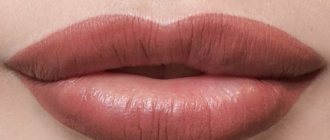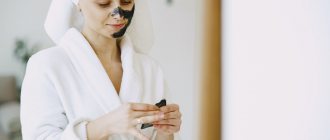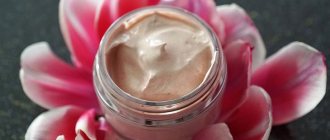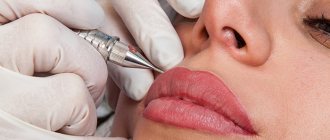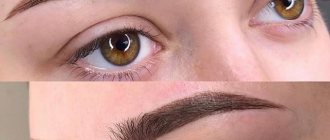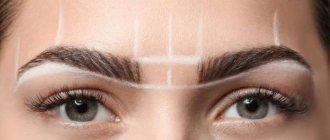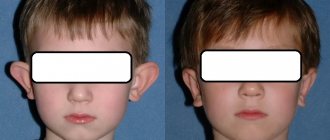Date of publication: 07/20/2017 Date of update: 10/26/2021 12142
Tattooing is the introduction of colored pigment under the skin using a thin needle. Depth – approximately 0.5-1 mm, area of influence – hairy part of the eyebrows. If the shape of the eyebrows needs to be changed, then the dye is applied beyond the boundaries of hair growth. This is also often done if the eyebrows are naturally very thin and you want to make them wider.
In the first days after the tattoo procedure (permanent makeup), eyebrows need care. Damaged skin should not be exposed to aggressive influences. In addition, until healing is complete, eyebrows do not look very beautiful. Therefore, plan a few days of “home” regimen after the procedure. If going outside is unavoidable, buy large sunglasses that cover your eyebrows.
Healing process
Immediately after the introduction of the pigment, the skin becomes inflamed, red, and swollen, but the next day it subsides. This is a natural reaction of the dermis to multiple needle punctures. The treatment area may “bleed” slightly, and ichor is released from it. The entire healing process, if the rules and recommendations are followed, takes up to 10 days. However, this period is purely individual. The main thing is to follow the instructions of the specialist who performed the procedure.
Recovery stages
The entire healing period can be divided into several stages:
- For the first 3 days, the eyebrows have a reddish tint, and a small amount of ichor is released.
- Over the next week, crusts form and fall off over time.
- After 10 days, the crusts disappear, the skin begins to peel off, increasing the brightness of pigmentation. After 14 days, the wounds heal, the skin is completely restored with new pigmentation.
- After a month, the skin is completely restored, the eyebrows acquire a natural shade and desired shape.
Everyone has their own healing time. It depends on the characteristics of the body and the method of tattooing. For example, when using the spraying method, fewer areas of the dermis are affected, so skin restoration occurs faster.
Washing after the procedure
wash your face in the usual way for the first 3-4 weeks after tattooing.
Note! In the first week, it is better not to do this at all, and if necessary, you should wipe your face with wet wipes.
Water that gets on the drying crust will contribute to the disruption of its integrity, and even if it does not cause additional inflammation, it can significantly slow down the healing process.
Naturally,
a full shower and bath, as well as visiting pools and beaches, are prohibited at this time .
Rules of care
The cosmetologist who performed the procedure should tell you in detail how to properly care for your eyebrows after tattooing. In the standard version, this looks like several mandatory skin care rules:
- After washing, do not use a rough towel. Remove moisture from the face using a soft cloth using small blotting movements.
- You should not peel off the crust that has formed; it must fall off on its own, otherwise the pigment will be absorbed unevenly.
- Try to avoid getting water into the tattoo area. Along with the liquid, an infection can be introduced, so you should wash your hair in advance.
- Do not take a hot bath or shower, and also refrain from going to the bathhouse or sauna until the skin has completely healed. When the skin is steamed, swelling and redness may increase.
- Do not use cosmetics, or wash your face with soap, foams, or gels containing alcohol.
- Avoid exposure to direct sunlight. In summer, it is recommended to use UV protection.
- Try to touch the tattooed area as little as possible. Do not remove or shave hairs near the eyebrow arches.
- While the recovery process is underway, you should not engage in active sports, as sweat can get on your eyebrows and cause an infection.
If you follow the rules, the risk of infection will be minimal. Proper skin care after permanent makeup is an important part of creating your beautiful look. If they are not followed, swelling and redness may intensify, hematomas will occur, and instead of a beautiful look, you will get many problems that will have to be addressed by a doctor.
Photo: what a fresh and healed permanent looks like
When choosing a permanent makeup artist, healing photos help the client make a decision. Photos and videos immediately after the procedure are not always indicative, especially if they are viewed not by a professional specialist, but by an ordinary person. After all, you need to understand that it is impossible to achieve 100% of the remaining pigment for natural reasons. While healing, the permanent loses some of its color - both in terms of filling and saturation.
Photos of the healed permanent show what the final effect looks like. There is no longer any redness or swelling on them, you can evaluate the shade and smoothness of the spraying.
Skin care after tattooing
On the first day after the procedure, the upper layer of the epidermis becomes inflamed and swollen, and in some cases blood may appear. This is the body's natural reaction to the multiple injuries caused by needles. Redness and swelling go away the next day, since the depth of the damage is very small. The complete healing process with proper care takes from 14 days to a month. But everyone’s body is individual, so these timings can be adjusted.
In the first days, the color of the eyebrows looks much brighter and unnatural, but as it heals, everything comes back to the way it was planned. Do not try to somehow disguise this process, this can cause harm and worsen the condition of the skin.
Is it possible to combine the procedure with alcohol?
Alcohol is an enemy of any invasive procedures , since alcohol increases blood pressure and any incisions and punctures begin to bleed heavily.
It is necessary to stop drinking alcohol one day (or preferably 2-3 days) before tattooing .
Otherwise, the following consequences are possible:
- tissue inflammation, as a result of which the regeneration processes will obviously proceed more slowly;
- increased leaching of paint with blood already during the procedure, and as a result – faded, uneven colors and contours that will have to be modified;
- vasodilation, which negatively affects the client’s condition as a whole;
- increasing the likelihood of contracting an infection. Some bacteria are inevitably introduced through punctures during the tattooing process, but the body can easily cope with them if the immune system is not suppressed by alcohol.
You should not drink for the next three days , as bleeding may occur and the paint will again be washed out.
Keep in mind! Ideally, it is better to avoid alcohol for the entire healing period.
First day after tattoo
The first day is considered the most difficult. The eyebrow ridges will hurt and ichor will be released, which will harden and tighten the skin. To remove the ichor, use cotton pads and blot the tattoo area using gentle movements in the direction of hair growth and drawing. You can use light ointments for pain relief.
On the first day, try to touch your eyebrows as little as possible. Antiseptic agents are used when treating skin:
- miramistin;
- non-alcoholic solution of 0.05% chlorhexidine;
- Vishnevsky ointment;
- levomekol;
- aqueous solution of furatsilin.
The antiseptic is applied to the skin using a spray or clean cotton swabs. You cannot use cosmetics or products that are not included in the list of products recommended by the cosmetologist. During the first healing period, try not to scratch the tattooed area and avoid unnecessary contact with water to prevent infection.
Why can't you remove crusts yourself?
Within a few days, the peeling should go away organically. At this time, the treatment area should not be wetted, touched, or steamed, so as not to harm the natural healing process and not spoil the result of the tattoo.
It is important not to help the scabs come off after permanent eyebrow treatment for several reasons:
- Due to the high probability of infection through open wounds left after mechanical removal of hardened particles.
- Due to the risk of damaging the eyebrow pattern. If you remove cracked particles yourself, you can touch unhealed areas of the permanent. Since the dye underneath has not yet been properly absorbed, the final pattern after healing will be uneven and spotty.
- Due to the possible prolongation of the recovery period. If the peeling is torn off before the due date, ichor will again be released from the unhealed wounds to form a protective layer. The places where crusts were mechanically removed will again be covered with “armor,” only less so. If you repeat such manipulations more than once, scars may remain on the skin.
If the crust comes off accidentally, the damaged area should be treated with an antiseptic - this will help prevent the risk of infection of the open wound.
Second day after permanent eyebrow makeup
On the second day after sleep there is a noticeable increase in color. This is considered normal, since during sleep the ichor is released along with the pigment. During this time, it hardens and turns into a solid dark crust. Skin care must continue as on the first day: blot the tattooed areas with cotton swabs with antiseptic agents.
On the second day, the secretion of ichor becomes significantly less, so the treatment procedure can be reduced to 4 times a day. At the end of the second day, pain and swelling become less.
Contraindications for laser hair removal
Laser hair removal is not for everyone, although it is effective. It is not recommended if there are any contraindications related to health conditions.
Diseases and restrictions for which laser hair removal of legs is not permitted:
- Acute phase of diabetes mellitus. In this condition, carbohydrate metabolism is disrupted, which leads to the appearance of ulcerations and wounds. In addition, with diabetes mellitus, regeneration of the epidermis occurs much more slowly.
- Taking antibacterial agents. The procedure is allowed only 2 weeks after completion of the course of treatment.
- Carrying out hormonal therapy. During this period, the desired effect may not be obtained, since hormones have a strengthening effect and accelerate hair growth.
- Pregnancy and breastfeeding. In this condition, the woman’s hormonal background changes, and therefore hair removal will be ineffective. The procedure can be performed at the end of lactation.
- Infectious or viral diseases of the skin of the legs. In this case, the laser can cause dangerous complications.
- Tumors of a malignant nature.
- Epilepsy.
- Diseases of the circulatory system.
- Acute phase of pulmonary tuberculosis.
- Acute period of cardiovascular diseases.
Warts and papillomas are a relative contraindication to laser hair removal. Whether or not to perform the procedure in this case is determined by a specialist depending on the individual characteristics of a particular client.
If the skin of the legs is damaged, there are scratches, abrasions, burns, hair removal is not recommended. You must wait until the damage has completely healed. Laser radiation does not affect gray hair, since it contains voids instead of colored melanin. In addition, laser is ineffective on light shades.
Care for the eyebrow tattoo area for 3-5 days
On the 5th day after the procedure, the crust begins to disappear, which confirms the correctness of the skin care and restoration process. From now on, it is allowed to use healing ointments or creams. The treatment course lasts 7 days.
After removing the crusts, there is a feeling of tightness and dryness of the skin, which is especially noticeable in the morning. You can solve the problem with Vaseline or baby cream. It should be applied after washing for 20 minutes, then removed. You are still not allowed to use cosmetics.
The following are used as healing ointments that can be applied:
- beponten;
- depanthenol;
- oxolinic ointment with antiviral properties;
- contractubex;
- solcoseryl;
- Vasiline.
Do not use alcohol-based ointments. Choose those that contain natural, natural ingredients. They will help not only with the rapid healing of wounds, but also soften and moisturize damaged areas of the skin.
What can't you do?
- For about 10 days you cannot steam the treatment area, go to the bathhouse or sauna, or use scrubs.
- Do not over-hydrate your skin if it is inflamed.
- It is advisable to protect the skin from sea water and chapping.
- For 2-3 weeks, avoid tanning - natural and in a solarium. For the next 3-6 months, you should apply sunscreen to your eyebrows before going out in the sun.
Nourishing creams should not be used. They often have an alcohol base and do not promote healing, but rather slow down the process.
Eyebrow care after 7-10 days
At the end of the first week after the procedure, the crusts, pain, and swelling go away, but discomfort in the arch area remains, associated with peeling and dry skin. This is due to several reasons:
- Excessive drying of the skin.
- Allergic reaction to pigment.
- Removal of crusts.
To avoid flaking and itching, use moisturizing ointments based on herbal products.
At the end of the first week, the resulting crusts completely disappear, but treatment with an antiseptic and moisturizer must be continued. Now you can see the shade of the injected dye, the updated shape and volume of the eyebrows. The color has not yet fully set. It will be brighter than planned, but every day its intensity will decrease, the shade will become more natural.
During this period, active restoration of a new layer of the epidermis begins, the wounds heal, and the recovery process is almost complete on days 10-14.
Peeling: before and after
Before starting the procedure itself, it is strongly recommended to carry out a set of preparatory measures: consult a doctor and identify possible allergies; to avoid the occurrence of herpes, undergo a course of treatment with immunomodulators; prepare the skin by washing for two weeks with diluted lemon juice (only natural!) in a ratio of one teaspoon per glass of warm boiled water.
After the procedure is over, you may be alerted by strange sensations: the skin seems to be tight. Cosmetic products will help cope with excessive dry skin - primarily moisturizing and nourishing creams, which contain hyaluronic acid, amino acids, proteins, urea, hydrogels, alginates. However, be careful in your choice. Only a doctor can accurately determine the remedy that is right for you.
Active consumption of still water will help restore the lipid barrier, as well as the use of cosmetics containing antioxidants, ceramides and phospholipids, lanolin and wax, panthenol and natural oils - it will have a healing effect.
Eyebrows a month after tattooing
If all skin care procedures were carried out correctly, after a month the new layer of epidermis will be completely restored and the final result of the new eyebrow arches can be assessed. At this point, the shortcomings and mistakes made when choosing the shape and shade of the pigment are visible. If any defects are identified, you should contact your technician to have them eliminated. Defects can have different causes:
- Poorly performed procedure.
- Incorrectly selected pigment tone.
- Failure to follow the rules of care after tattooing.
- Use of non-certified materials.
The resulting defects can be corrected and completely eliminated. All additional procedures to eliminate defects are carried out only after complete healing of the upper layer of the epidermis.
Noticed deficiencies can be recorded on your phone and shown to the specialist who will make the correction. If you are not completely satisfied with the result, it is better to replace the artist or the salon where the procedure was performed and remove the tattoo completely.
Lip frenuloplasty
Another operation that requires surgical intervention is plastic surgery of the frenulum of the upper lip. It is carried out on the recommendation of an orthodontist (for example, if the patient needs to correct the bite in the future using a plate or braces) or a speech therapist (if the frenulum interferes with articulation).
The labial frenulum is responsible for additional attachment of the upper or lower lip to the jaw bones. Most often the upper frenulum undergoes surgery. This operation does not take long and does not have any negative physiological or aesthetic impact on the patient’s health and appearance.
Rules of care after frenuloplasty
If you have undergone this minor operation, then you need to know about the rules of oral care for the first time after the operation.
Two to three hours after the operation, you can apply cold to the lip. It is strictly forbidden to consume hot food on the day of the operation. Brushing your teeth in the next 24 hours is also undesirable, as is rinsing your mouth. Every other day, you can rinse your mouth with chamomile infusion.
Avoid contact of the operated surface with the tongue and dirty hands. Do not touch the wound. If you feel itching and burning at the operated site, you can take a pain reliever. But remember that taking aspirin is strictly prohibited, since it affects blood clotting.
Non-standard situations
Each body reacts to the administration of the drug in its own way. Sometimes allergic reactions to the pigment may occur. If after the procedure the swelling and redness do not go away within 24 hours and spread to the eyelids, you should take antihistamines:
- suprastin;
- lorantandine;
- tavigil;
- Zyrtec or other anti-allergy drugs.
Observation of the body's reaction takes place within 4-8 hours. If the allergy does not go away, the pigment will have to be removed and the pattern removed.
In cases of infection of the eyebrow arches, a doctor's examination and medical intervention will be required. Be sure to take blood tests to determine the causes of skin inflammation.
Possible complications after laser hair removal
Advertising brochures often praise laser hair removal, talking about its complete safety and the absence of complications on the skin. Can you believe this? Despite the fact that the procedure is gentle compared to other methods of removing unwanted vegetation, it can cause complications such as:
- skin burns;
- inflammation of hair follicles;
- allergies;
- exacerbation of herpes;
- acute phase of acneiform rash.
Burns can be caused by the following factors:
- very high energy flow is used;
- the wrong procedure technique is used;
- The laser affects hypersensitive areas.
After laser hair removal, an allergic reaction may occur:
- hives;
- severe itching;
- contact dermatitis.
It happens that the skin reacts with allergic rashes in response to care products or anesthetics. It is not recommended to continue the procedure if the cause of the allergy is not clear. After the skin returns to normal, you can continue hair removal sessions. Antihistamines and glucocorticoids (topical forms) are used to treat allergies.
The most common consequence of laser treatment is folliculitis, which appears 2-3 days after the procedure. The cause of this complication is a bacterial infection, which manifests itself in the form of red dots filled with white contents. The skin is irritated and hyperemic. In addition, folliculitis is often accompanied by pain and itching.
If during the hair removal course a woman visited a bathhouse, sauna or swimming pool, the hair follicle may become inflamed.
It happens that this disease is observed in people suffering from hyperhidrosis.
Important aspects of the treatment of folliculitis that appears on the legs after laser hair removal: do not touch the areas of inflammation, do not open the formations, scrubs and other rough means must be avoided. In addition, you need to use only clean towels, do not apply cosmetics to inflamed skin, and wear freshly washed clothes made from natural materials.
The surface of the skin is treated with creams and solutions with an antiseptic effect: Bactroban, Miramistin, chloramphenicol.
If after several days the inflammatory process does not stop or the condition gets worse, you need to consult a doctor for a diagnosis and treatment. You should not take antibiotics on your own.
To avoid complications, it is not recommended to carry out the procedure if there are any contraindications.
Swelling after permanent makeup: what to do
Swelling of the arches after the tattooing procedure is a completely natural phenomenon, because in the process the upper layer of the epidermis is damaged. The body responds to minor damage to the skin with edema. In addition, the cells of the dermis react to the injected drug, which is foreign to them.
In normal conditions, swelling and redness go away after a couple of days. If swelling persists longer and is accompanied by pain and itching, you should consult a dermatologist. At home, you can take an anti-allergenic agent, since the most common cause of this situation is the occurrence of an allergic reaction to the injected pigment.
Coming out of anesthesia
Most types of oral surgery are performed using anesthesia. A person can “recover” from anesthesia for several hours after the operation. Then the patient experiences ailments such as fatigue, drowsiness, and poor concentration. There are several ways to get rid of side effects of anesthesia.
- The first way is to move as much as possible, but without excessive physical activity, which can cause bleeding.
- The second way is to drink plenty of fluids, but only a few hours after the operation. It is necessary to drink ordinary mineral and always still water.
Carrying out surgical operations in the oral cavity requires subsequent special care of teeth and gums. The postoperative period will become much shorter if the listed recommendations are followed. If you experience any serious complications, prolonged bleeding, or if you cannot “bring down” the increased temperature, then this is a reason to immediately contact your dentist. Only he can help you and provide additional recommendations.
Features of care at different times of the year
The restoration of the epidermis after permanent makeup is influenced by the period of its implementation. During the warm season, cells secrete more sebum, which makes the dermis oily. At the same time, in the summer there is a lot of dust and dirt in the air, which means the risk of infection increases. Ultraviolet radiation negatively affects the pigment, discoloring it. Therefore, when carrying out tattooing in the summer, you should adhere to the following rules:
- Be sure to use a cream with 30-50 SPF protection.
- For the first 10 days, you should not stay in the sun for a long time, sunbathe or sunbathe. If you are planning a trip to the south, plan to get a tattoo a month before your trip.
- After the crusts come off, use a cream with vitamins A, C, B to moisturize. This will protect against swelling and dry skin.
In winter, when the cold wind dries out the skin and the immune system weakens, healing of the dermis takes longer. The skin is constantly exposed to sudden changes in temperature, which has a detrimental effect on its condition; the following tips will help change the situation:
- A week before the planned procedure, take vitamin complexes and immunostimulants to strengthen the body.
- After 4 days, use Vaseline-based ointment to improve skin regeneration and healing.
- Apply a moisturizer with vitamins 3-5 hours before going outside.
It is important that after permanent eyebrow tattooing, you know how to properly treat the skin in the areas where it is applied, this will help avoid complications.
In the end, we note that permanent eyebrow makeup will be an excellent solution for all modern women who, due to lack of time, do not have time to apply makeup in the morning. At the same time, eyebrow tattooing allows you to improve the color and adjust the shape of the arches, which cannot be done as naturally as possible with regular paint or pencil.
What influences the process of epidermal restoration?
Optimal and rapid fixation of the pigment is ensured by the hypoallergenic and sterile properties of the dye, that is, the less allergenic they are, the more favorable the process of pigment fixation (healing). This depends on the pH of the paint, on the purity of the component itself and on the non-use of components that have toxic properties. The quality of the needles used, the alloy of the steel, and the absence, for example, of nickel in the alloy (which causes long-term inflammation and healing of the skin) are important. Manufacturing and sharpening of needles, combination of composite materials in the production of cartridges and their guarantee of sterility.
As a result of all that has been said, we can conclude that permanent eyebrow makeup depends to a large extent not only on care, but also on the professional and competent approach of a specialist.
With this approach, healing proceeds calmly and unnoticed by the person, that is, it does not cause additional difficulties or inconveniences. It is enough to follow the recommendations of your specialist. As a rule, it is enough to moisturize the epidermis of the eyebrows with the product suggested to you and do not exfoliate the crust yourself (do not steam or peel off), but wait for natural exfoliation during the first week. And within a month, wait for the skin to completely recover and achieve the desired result.

